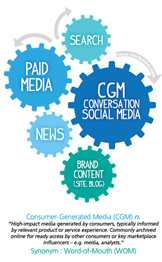INSIDER: Tell 3000 Friends
By Mark Chou, MBA Candidate May 2010
In this age of emerging technology, the modern homebuyer holds countless devices to discuss his experiences with other peers. Tools from blogs, videos, consumer websites, and simple word-of-mouth open the gates to a new era of consumerism. Consumer generated media (CGM) refers to the use of these mediums to communicate one's experiences with service and product providers. In his book, titled Satisfied Customers Tell Three Friends, Angry Customers Tell 3000, Pete Blackshaw, a senior officer of the AC Nielsen company explains the recent hype over consumer-generated media in response to negative and positive experiences. To avoid retaliation from prospective homebuyers, real estate agents must focus on enhancing the client's purchasing experience.
Think Point #1: The real estate market is saturated with advertising and marketing messages over the quality, dedication, and commitment of its agents. However, homebuyers observe an agent's credibility. In fact, in this market where homebuyers have unlimited options, credibility is critical. Some of the key credibility drivers and their activation methods are:
- Listening: Keeping communication channels open and inviting feedback
- Responsiveness: Taking a proactive approach with customer-related issues
- Transparency: Being open about practices and policies during the process -- Transparency involves full disclosure
- Trust: Establishing meaningful, win-win relationships
- Authenticity: Caring, truly caring, about the customer
Think Point #2: Buying a home can be a challenging and stressful experience. Those agents who can provide homebuyers with an enjoyable interaction will reap the best CGM results. Indeed, one of the main motives behind CGM creation is a positive purchasing experience. The use of technology and expanded social networks from satisfied clients can become a source of free publicity for the real estate agency. So, an agent might want to consider what s/he is doing in the client-engagement process that can reduce stress and build pleasure for the buyer.
Think Point #3: It goes without saying that real estate agents need to nurture the buyer-seller relationship. Challenge the client to stay involved by using your expertise to help frame the decision-making process. Homebuyers who actively engage in and enjoy the decision-making process will communicate their experiences to others. It can prove useful to perform checks after each transaction to evaluate client feedback. Does the client "feel we are making progress?" And, importantly, "is the client enjoying the home-buying process?" These questions will allow the agent to estimate how s/he is perceived by clients and assess whether new issues should be addressed. Such data gathered by the broker can provide insights on where additional agent training might be needed.

Think Point #4: An agent is the image of the broker's operation and the overall brand. So, the agent should never promise what s/he cannot deliver because such actions impact the agent's credibility, the broker's credibility, and the overall brand equity. Whenever one fails to deliver the appropriate information or meet client expectations, clients then have the ability to communicate this to "the greater public" through the use of technology. While the influence pattern used to be one-way (i.e., businesses influenced consumers' perceptions and behaviors), consumers now have far greater power to express their grievances with the home-buying process, thereby influencing other consumers' perceptions of the agent, the broker, and the brand. Consumer-to-consumer communication should not be underestimated.
Think Point #5: Evaluating key CGM metrics available through mainstream technology and using client surveys can help the agent respond accordingly and maintain/build the agent's, the broker's and the brand's current reputation. Metrics that can be evaluated regularly include:
- Volume: How many messages about the agent are there?
- Emotion: How do clients feel about the agent's service?
- Sentiment: How favorable or unfavorable are these public messages?
- Issue: What specific issue is being addressed in th,ese public messages?
- Reach: How widely are these public comments spread?
. . . . . . . . . . . . . . . . . . .
Recommended Reading
Blackshaw, Pete (2008), Satisfied Customers Tell 3 Friends, Angry Customers Tell 3,000, Random House Publishers.
. . . . . . . . . . . . . . . . . . .
About The Author
Marc Chou, MBA Candidate, December 2010, Baylor University Graduate Assistant, Keller Center for Research. Marc is a first-semester graduate student from Paris, France. He earned his BBA with a double major in Finance and Entrepreneurship from Baylor University.